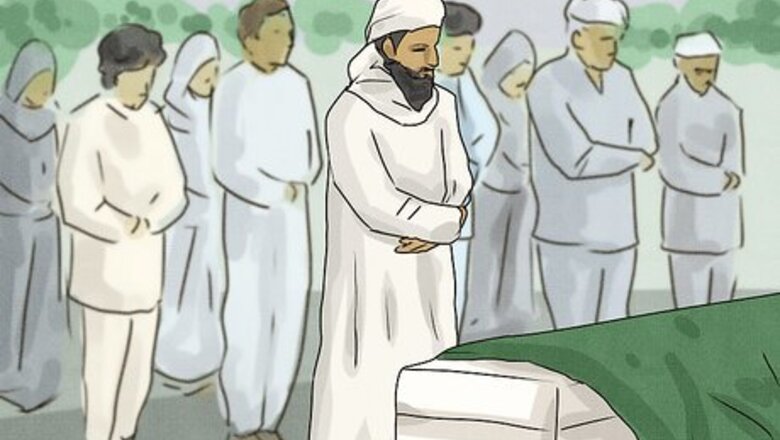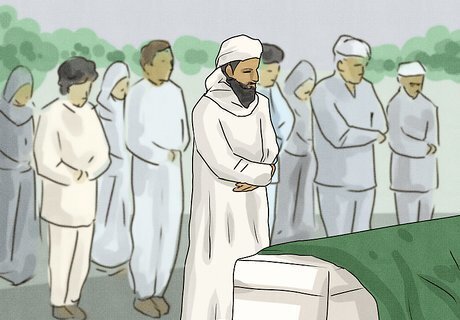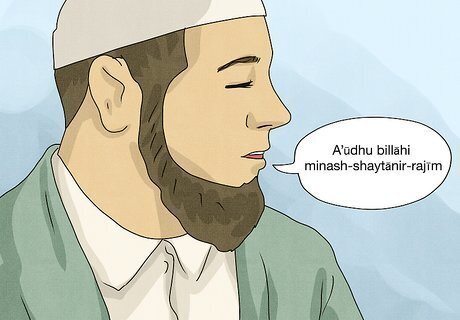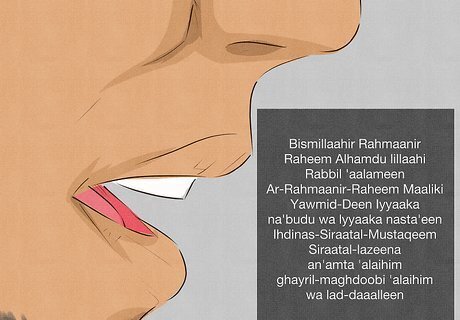
views
Line up in rows behind the imam.

The Janazah is performed standing in straight lines. These lines face the Qiblah, and it’s recommended that there are at least 3 of them. Women stand in rows behind the men. Take your place among the other men or women—the imam stands in front of you, by the body of the deceased. Before attending the funeral, it’s customary to perform wudu, the traditional Islamic purification ritual. Wudu is best performed at home, before the funeral.
State your intention to pray (niyya).

Alert Allah that you intend to make a prayer for the dead. You don’t have to say this out loud—you can state your intention to pray in your head, and in whatever language is most comfortable for you. You can use your own words, but as a suggestion, try saying something like: “I intend to pray for the sake of Allah Most High and to supplicate for the deceased.”
Follow the imam for the first takbir.

The first takbir signals the beginning of the Janazah. The imam says “Allahu Akbar” (“God is great”), and the audience repeats this phrase. For many Muslims, it’s customary to raise your hands to your ears while saying the takbir, then lower them. Before the first takbir, there is no adhan or iqama (the traditional calls to prayer). The Janazah starts immediately.
Pray for refuge from Shaytan.

The imam then leads the audience in a prayer for safety from evil. After the first takbir, the imam calls for protection from Satan, the accursed. While he performs this prayer out loud, you can recite these words silently: “A’ūdhu billāhi minash-shaytānir-rajīm” Meaning: “I seek refuge from Satan, the outcast.”
Recite the Surah al-Fatihah.

The congregation then recites the first chapter of the Qu’ran. The imam will do this aloud, while you can recite this chapter in your head. Some imams may choose to recite an additional passage from the Qu’ran afterward—this isn’t strictly necessary, but it’s fairly common. Surah al-Fatihah goes as follows: “Bismillaahir Rahmaanir Raheem Alhamdu lillaahi Rabbil 'aalameen Ar-Rahmaanir-Raheem Maaliki Yawmid-Deen Iyyaaka na'budu wa lyyaaka nasta'een Ihdinas-Siraatal-Mustaqeem Siraatal-lazeena an'amta 'alaihim ghayril-maghdoobi 'alaihim wa lad-daaalleen” Meaning: “In the Name of Allah, the Beneficent, the Merciful. All praise belongs to God, Lord of the Universe, the Beneficent, the Merciful and Master of the Day of Judgment. Lord, You alone We do worship and from You alone we do seek assistance. Lord, guide us to the right path, the path of those to whom You have granted blessings, those who are neither subject to Your anger nor have gone astray.”
Say the second takbir.

The imam then performs the second of four takbirs. He once again says “Allahu Akbar,” and the audience follows his lead. During this takbir, you can choose to raise your hands to your ears once again, leave them by your sides, or keep them folded in front of you.
Recite the durood-e-Ibrahim.

After the second takbir, it’s customary to pray for Muhammad (PBUH). Say this prayer out loud, along with the rest of the audience. The imam will lead you in prayer. These salutations to Muhammad and His family are the same as those you would offer during your daily prayers. Recite the following words: “Allahumma Salle ‘Alaa Muhammadinw Wa’Alaa Aali Muhammadin Kamaa Sallaeta ‘Alaa Ibraaheema Wa’Alaa Aaali Ibraaheema Innaka Hameedum Majeed. Allahumma Baarik ‘Alaa Muhammadinw Wa’Alaa Aali Muhammadin Kamaa Baarakta ‘Alaa Ibraaheema Wa’Alaa Aaali Ibraaheema Innaka Hameedum Majeed” Meaning: “O Allah, send peace on Prophet Muhammad and to the family of Prophet Muhammad as you sent peace on Prophet Ibrahim and the family of Prophet Ibrahim. Indeed, you are praiseworthy and glorious. O Allah, bless the Prophet Muhammad and the family of Prophet Muhammad as you blessed Prophet Ibrahim and the family of Prophet Ibrahim. Indeed, you are praiseworthy and glorious.”
Say the third takbir.

The imam then leads the congregation in the second to last takbir. Follow his lead as he says “Allahu Akbar.” Raising your hands to your ears is optional once again—you can also choose to keep them respectfully folded in front of you or by your sides.
Perform a dua for the dead.

The dua is your opportunity to personally pray for the deceased. After the third takbir, you can take some time to pray to Allah in your head in whatever language feels most comfortable to you. This prayer can a personal one where you express your heartfelt wishes for the deceased to find peace. However, if you want to use a traditional dua, this one is particularly well-known: “Allaahum-maghfir lihayyinaa, wa mayyitinaa, wa shaahidinaa, wa ghaa’ibinaa, wa sagheerinaa wa kabeerinaa, wa thakarinaa wa ‘unthaanaa. Allaahumma man ‘ahyaytahu minnaa fa’ahyihi ‘alal-‘Islaami, wa man tawaffaytahu minnaa fatawaffahu ‘alal-‘eemaani, Allaahumma laa tahrimnaa ‘ajrahu wa laa tudhillanaa ba’dahu.” Meaning: “O Allah! Forgive our living and our dead, those who are with us and those who are absent, our young and our old, our men and our women. O Allah, whoever you give life from among us, give him life in Islam, and whomever you take away from us, take him away in Faith. O Allah, do not forbid us their reward and do not send us astray after them.”
Say the fourth takbir.

The imam then performs the final takbir. He says “Allahu Akbar” for the last time, and the audience repeats after him. During this takbir, you can raise your hands to your ears, keep them folded in front of you, or hold them by your sides.
End the prayer with a taslim.

The Janazah concludes with the standard closing portion of a prayer. The imam will say “As-salāmu ʿalaikum wa-raḥmatu-llah” (“Peace and blessings of God be unto you”). Repeat this phrase while turning your head to your right. Unlike during regular prayers, many Muslims only perform this taslim a single time to their right, rather than both to their left and right.




















Comments
0 comment